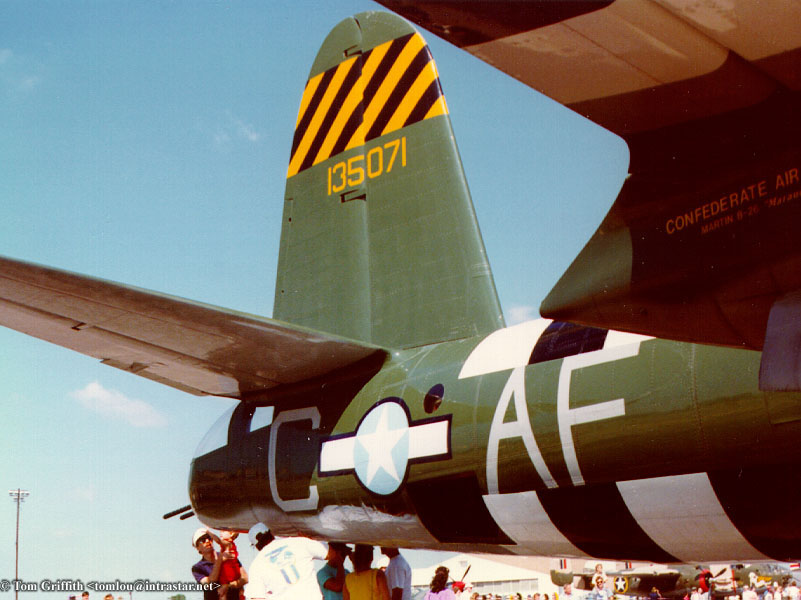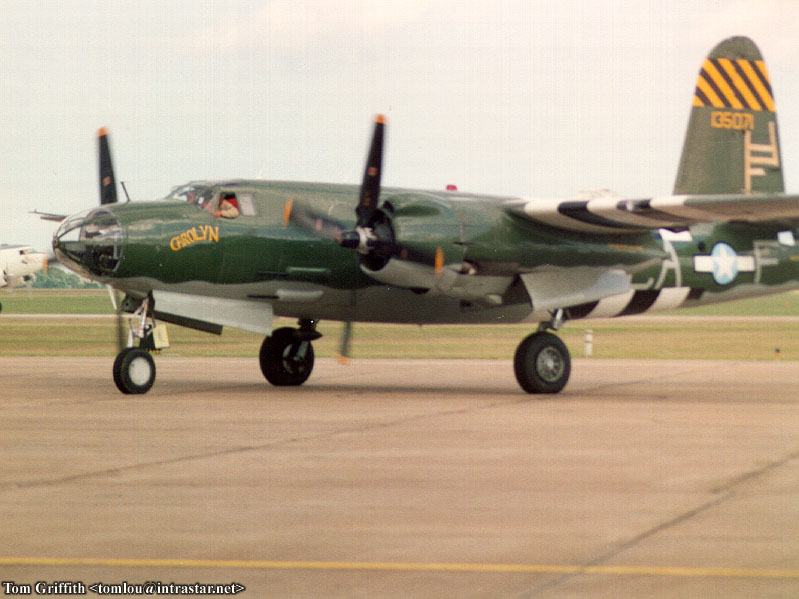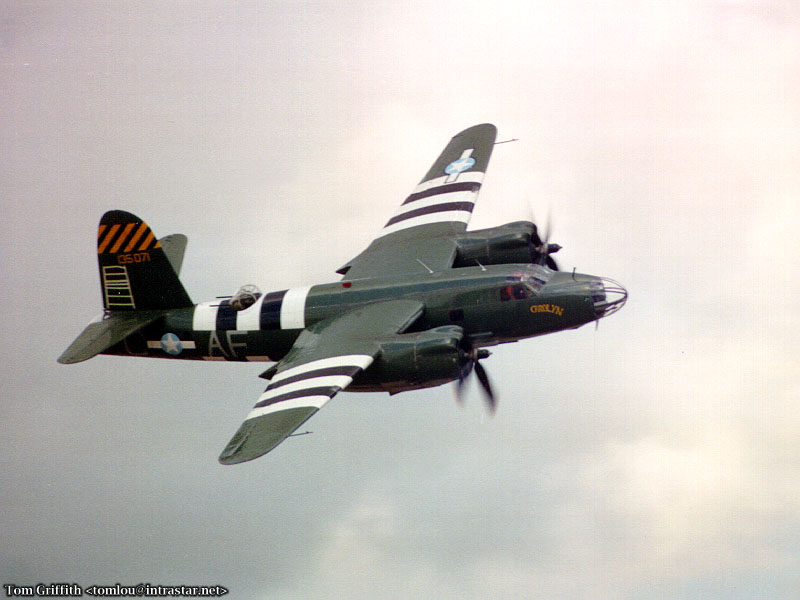

|
|
B-26 Carolyn
Martin B-26C-20-MO Marauder
Sn: 41-35071
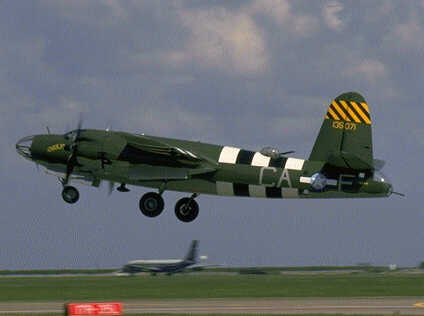 The B-26 Carolyn was operated by the Confederate Air Force, a flying organization
that restores and flies vintage military aricraft. The aircraft's tail
is painted with the diagonal yellow and black "tiger stripes" of the 387th
Bombardment Group (Medium). The aircraft serial number is painted immediately
beneath the tiger stripes. The letters "CA-F" are squadron/aircraft designation
markings and are here the initials of the Confederate Air Force; for an
aircraft actually assigned to the 387th the first two letters would have
been FW, KS, KX or TQ, depending on the squadron, and the last letter would
have identified the aircraft. The Carolyn also bears black and white "Invasion
Stripes" used during the D-Day invasion; since the Allied naval and ground
forces participating in the invasion had little experience in aircraft
recognition, such stripes were painted on all Allied aircraft participating
in the invasion to enable them to tell at a glance whether an aircraft
was friend or foe.
The B-26 Carolyn was operated by the Confederate Air Force, a flying organization
that restores and flies vintage military aricraft. The aircraft's tail
is painted with the diagonal yellow and black "tiger stripes" of the 387th
Bombardment Group (Medium). The aircraft serial number is painted immediately
beneath the tiger stripes. The letters "CA-F" are squadron/aircraft designation
markings and are here the initials of the Confederate Air Force; for an
aircraft actually assigned to the 387th the first two letters would have
been FW, KS, KX or TQ, depending on the squadron, and the last letter would
have identified the aircraft. The Carolyn also bears black and white "Invasion
Stripes" used during the D-Day invasion; since the Allied naval and ground
forces participating in the invasion had little experience in aircraft
recognition, such stripes were painted on all Allied aircraft participating
in the invasion to enable them to tell at a glance whether an aircraft
was friend or foe.
HISTORY
The aircraft that became
the Carolyn never saw combat. It was factory modified into a model AT-23B,
later redesignated TB-26C. United Air Lines purchased it from the Walnut
Ridge disposal operation in September 1946. It was resold to Allied Aircraft
Company in 1948. The aircraft was entered in the 1949 Bendix Air Race,
but failed to finish on time. The Tennessee Gas Corporation (Tenneco) purchased
it in late 1951 for use as an executive transport. It later became
N550T, B-26C-T and reverted to N5546N in 1957. It was sold again
in 1959 and later registered in Mexico as XB-LOX. The aircraft was returned
to US in 1965. It was grounded due to the corrosion of one of the main
spars.
The Confederate Air Force
bought the plane in 1967 with the intention of restoring it to flying condition.
This took considerable effort, since no structural B-26 parts were then
available anywhere in the world and all B-26 engineering and production
data had been destroyed in a fire at Martin's Baltimore plant. Most needed
components had to be made by hand. It was painted with the tiger stripes
of the 387th Bombardment Group, and named "Carolyn" in honor of a generous
contributor. The restored aircraft took to the air in 1984 as N5546N.
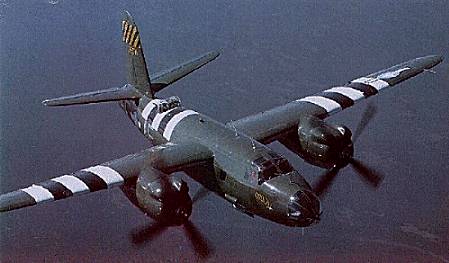
The invasion stripes on the wings are more clearly visible in this top-down photograph. |
THE CRASH OF THE CAROLYN
On September 28, 1995, the "Carolyn" crashed as it was returning to the Confederate Air Force HQ at Midland, Texas, from a pilot qualification flight made in preparation for the "CAF Airsho 95." The aircraft was on approach at an altitude of 250 feet when it apparently lost engine power and abruptly veered to the right and nosed into the ground. The "Carolyn" was destroyed in the crash--all five crewmembers aboard died. The National Transportation Safety Board investigated the accident and published the following summary of its findings:
NTSB Identification: FTW95FA406
Accident occurred Thursday, September 28, 1995 at ODESSA, TX
Aircraft: MARTIN B-26C, registration: N5546N
Injuries: 5 Fatal.
The full NTSB report is available at Final Report ot the National Transportation Safety Board.Witnesses observed the aircraft approximately 250 feet above the ground heading towards the southwest. As the aircraft passed overhead, the 'engines were sputtering.' Approximately 3/4 mile from the witnesses, the aircraft made a 'sharp' right turn, nosed down, and impacted the ground. The engines 'quit' prior to the aircraft turning right. According to the operator, the flight was in preparation for a flight evaluation for the pilot-in-command by an FAA inspector. The pilot reported to Departure Control that he would be 'working on stalls and steep turns,' and the pilot was instructed to 'maintain VFR at or above five thousand five hundred.' The pilot-in-command had accumulated approximately 500 hours in the B-26. Prior to the accident flight, he had flown the B-26 once since October 8, 1993. That flight was on September 26, 1995, for a duration of 30 minutes. Prior to the flight the fuel tanks were 'sticked' and the total fuel was approximately 720 gallons of 100 octane low lead avgas. Examination of the airplane and engines did not disclose any premishap discrepancies. Due to the extent of damage, flight control continuity could not be established.
The National Transportation Safety Board determines the probable cause(s) of this accident as follows. the failure of the pilot to maintain minimum airspeed for flight resulting in an inadvertent stall/spin. Factors were the loss of power for undetermined reasons, and the pilot's lack of recent flight experience in the aircraft.
The circumstances of the
crash of the Carolyn are reminiscent of some of the difficulties that plagued
the B-26 in stateside training during the war. The aircraft has a minimum
single-engine control speed of about 160 mph; below that speed the rudder
cannot provide sufficient control to offset the torque imbalance caused
by flying on a single engine. The following comments by others with relevant
knowledge and expertise provides additional insight into the circumstances
surrounding and the cause of the accident:
William Taylor, Staff Writer, "Pilot Blamed in Odessa Crash," St. Angelo Standard-Times (September 6, 1996).
J. Stoll, E-mail (09:17pm Oct 31, 1998).Federal investigators have questioned the experience of the pilot of the world's last B-26 bomber that went down near Odessa a year ago and placed the blame on him for the fatal crash.
The pilot, Vernon E. Thorp, 77, of Ocala, Fla., and all four others on board died in the Sept. 28, 1995, accident.
The rare World War II vintage plane belonged to the Confederate Air Force and was the only B-26 still flying at the time of the crash.
On Thursday, the National Transportation Safety Board provided the Standard-Times with a copy of its findings.
The board found - among other things - that the probable cause of the accident was "the failure of the pilot to maintain minimum airspeed for flight, resulting in an inadvertent stall-spin.
"Factors were the loss of power for undermined reasons, and the pilot's lack of recent flight experience in the aircraft,'' the board reported.
"Witnesses observed the aircraft approximately 250 feet above the ground heading toward the southwest,'' the report said. "As the aircraft passed overhead, the 'engines were sputtering.' Approximately 3/4 mile from the witnesses, the aircraft made a 'sharp' right turn, nosed down and impacted the ground.''
The pilot had reported to Departure Control that he would be ``working on stalls and steep turns'' and was instructed to fly at or above 5,500 feet.
Pilot error is a factor in 75 percent of all crashes, according to board officials.
Thorp was an experienced pilot.
In fact, he had accumulated more than 21,000 hours of flight time, including 500 in the B-26. But prior to the 1995 accident, Thorp had only flown a B-26 once since Oct. 8, 1983, the report said. "That flight was on Sept. 26, 1995, for a duration of 30 minutes.''
The crash cost the Confederate Air Force three of its most experienced pilots.
In addition to Thorp, Walter A. Wooton, 53, of Harlingen and John Thomas Cloyd, 64, of El Paso died in the crash.
Also killed were two volunteers - Colin Dunwell of Surrey, England, and Chris Gardner of Essex, England - who were taking their first flight on the B-26.
Thorp and his crew were flying in preparation for AIRSHO 95 at the Midland International Airport.
The twin-engine Martin Marauder named "Carolyn" was built in 1943. It was one of 134 World War II aircraft that the Midland-based organization restored and owns.
John Ford, Maurauder Thunder (November, 2000).Re: Crash of the CarolynMy father and I flew in "Carolyn" when she was in Harlingen, Texas, with the CAF (back when it was stationed there), for airshows. The details of the crash, to my knowledge, were never *truly* released.
One of the duties that my father used to perform on the plane every morning, especially after the plane had been sitting for awhile, was to purge the fuel tanks of water (since water sinks in fuel, this is a very easy task) by valving off the bottom portion of each tank. This was not done the day that "Carloyn" crashed, however, this is not a popularly known fact. "Carolyn" was flying at less than 300 feet - I forget the exact number now - and both her engines died, making it impossible for Walter to pull out before crashing, killing all 5 aboard. The only cause blamed was water in the fuel.
Dear Sir:PHOTOGRAPHSWhile reading the latest edition of Maurauder Thunder Lt. Col. C.B. Holland made reference to having seen the B-26 of the Confederate Air Force at Harlingen, Texas. It reminded me of a visit I made to the Confederate Air Force and that B-26 a few years ago.
During the end of 1944 and in 1945 until the end of the war I was an instructor pilot in the Maurauder at Laughlin Field, Del Rio, Texas. Many years later, as a Christmas present, my five children and my wife made arrangements for me to have a ride in the Carolyn and hopefully to take the controls once again. My eldest son, who engineered this gift and who was a little two year old when I went to Del Rio, took that ride with me.
I lately heard, although not authoritatively, that the Carolyn crashed on approach, or on simulated approach. I don't know whether you will find my observations on my flight in the Caroyln something you want to include in some future edition of Maurauder Thunder, but I will send my observation to you and leave that decision to you.
While at Del Rio, standard landing procedure was to come over the runway at 1500 feet, make a 180 descending turn to traffic pattern level on the downwind leg and hold that altitude until we turned on to the approach leg at which time we cut power and landed power off. This procedure of power off landings was the result of a crash on a landing that occurred when a pilot lost power on a low approach with wheels and flaps down, at low airspeed "dragging it in" with plenty of power. He was low, he was "dirty", and he was at low airspeed. As this was a transition base, procedures were established to deal with student pilots who had little time in the 26.
The two pilots with whom I flew in the Carolyn were capable pilots, but they seldom flew the plane and I'm sure never practiced single engine procedure. Something I did constantly with my students. I noticed two procedures they used which I thought were dangerous for pilots who flew the Carolyn but perhaps a couple of times a month, if that.
1. They used the long low approach with lots of power, flaps and wheels down, and low airspeed, and
2. The left seat pilot held the yoke in both hads during his approach to landing while his copilot had his hand on the throttles. This meant that the pilot had to tell his copilot he wanted power or to reduce power, or the copilot had to try to guess. In an emergency I wouldn't want to have to take the second or two to get that idea across to the copilot.
Either of these two practices could have been the cause of the crash of the Carolyn. The two pilots with whom I flew were the pilots in the Carolyn at the time of the crash.
Lots of pilots could fly the B-26 as long as things were going well. It was when things got unexpectedly exciting that one needed the practice and experience to successfully deal with them in the Maurauder. And this, those two didn't have.
I remember telling my son as we left the Carolyn after our flight that I was afraid that was an accident waiting to happen.
John (Jack) Ford.
